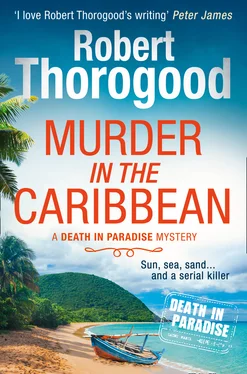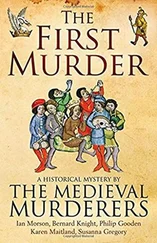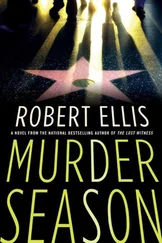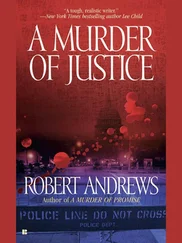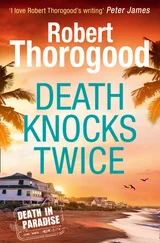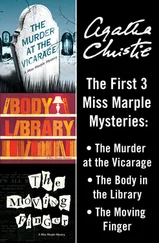‘Oh, that was later that day.’
‘It was?’
‘I was in my kitchen when I heard a car pull up outside. I didn’t think much of it, and I didn’t even see which of the men had come back, but I saw the first man who’d arrived that day – the man in the blue jacket – step out of his house. I could see that from my window. He said something and then I saw him leave. A few seconds later, I heard a car start up and drive off.’
‘Did you hear what he said?’
‘I think he said something like, "I thought I’d never see you again."’
‘"I thought I’d never see you again"?’
‘And I’m sure he said something else, but I didn’t catch it. But he then walked from the house, and you know what? Now you mention it, I’ve not seen him since. Or any of the other three men, either, for that matter. Not that I’d recognise them, of course.’
‘Have there been any other visitors since then?’
‘No. No-one.’
Richard looked back over the notes he’d taken, trying to make sense of what he’d just learned. Who were the three men who’d visited Pierre on the day he left prison? Where had Pierre then gone off to when one of them returned later on? And, seeing as Pierre very obviously hadn’t been back to his halfway house since then, where was he now?
As for the identity of the three men who’d visited that day, Richard had a theory he wanted to test, especially considering how Pierre had apparently been overheard demanding to know where ‘his share’ was.
Richard asked Camille to take the old woman’s formal statement, and while she was doing that, he drove back to the Police station.
As he entered the main office, Fidel stood up excitedly.
‘Sir, I’ve got something.’
‘You have?’ Richard said.
‘I sure have, because I’ve been processing the evidence Camille bagged from Conrad’s office. And you know that chunk of concrete that was used to smash in the window? I’ve been checking it for fingerprints, and guess what? It’s borderline admissible, but I was able to lift half a thumbprint from a pebble that was buried in its side.’
As he spoke, Fidel led Richard over to his desk and showed him the chunk of concrete. Bending down to inspect it more closely, Richard could see that it was rough–there’d be no way to lift any kind of usable fingerprints from it – but Richard could also see that a few smooth pebbles were embedded in the block, and Fidel had dusted each of them with graphite powder.
‘And?’ Richard asked.
‘The fingerprint also belongs to Pierre Charpentier, sir.’
‘It was Pierre who threw the rock through the window?’ ‘It was.’
‘Then that’s exactly what I wanted to hear.’
‘It is?’ Fidel asked, surprised.
‘Oh yes, because I think Pierre killed Conrad for a very specific reason and then left that fake ruby behind for the exact same reason.’
As Richard went and sat down at his desk, he told Fidel that a taxi had taken Pierre to his halfway house on the morning he was released from prison.
‘So contact the prison, would you? Find out what taxi firm picks up prisoners, and see if you can talk to the driver who drove Pierre that day. In particular, I want to know what sort of mood Pierre was in on the journey.’
‘Yes, sir.’
As Fidel started making calls, Richard logged on to the Saint-Marie Police Computer Network and called up the case file for Pierre Charpentier’s original crime. And what Richard read held him spellbound. Because, as he’d already guessed, Pierre hadn’t robbed the jewellery shop in London twenty years before alone. He’d been part of a gang of four. The men had driven up to the store on motorbikes just as a consignment of jewellery was being delivered. They’d then smashed up the shop with baseball bats until the manager handed over the delivery. Then, as they were leaving, one of the men pulled a handgun and shot a member of staff dead.
Richard read that the man who was killed that day was called André Morgan. He’d only been with the shop for three months, but what Richard noticed at once was that André was originally from Saint-Marie.
That would have to be followed up.
As for the men in the gang, they’d fled on their motorbikes just before the Police arrived at the scene.
However, the robber who’d fired the gun made one mistake. As he jumped onto the back of his partner’s bike to make his escape, his gun fell from his grasp and he wasn’t able to pick it up before the bike had driven off. This meant that although the bank robbers got away with their loot, the murder weapon was left behind at the scene, and was later retrieved by the Metropolitan Police. They were then able to lift a couple of fingerprints from the barrel of the gun. But the fingerprints didn’t match anyone on the UK Police database. Nor did they match anyone on Interpol’s database. In fact, the Police weren’t able to match the fingerprints with anyone. Even worse, although the motorbikes were later found dumped in a back street, the men had vanished into thin air. And the bikes had been stolen from Brick Lane the night before, so that was a dead end as well.
All told, over two million pounds’ worth of jewels had been stolen that day, and the Police didn’t have a single credible lead.
Then, a week after the jewellery heist, the Police received an anonymous phonecall. The message was left by a woman who, according to the notes Richard was reading, ‘had a thick Caribbean accent’. She told the Duty Officer that the jewel heist had been carried out by men from Saint-Marie. The woman hung up before she could be quizzed any further. The anonymous phonecall was later traced to a phone booth near Willesden Green Tube station, but the Police were never able to identify who the caller had been.
However, the tip-off meant that the Police in London sent copies of the fingerprints they’d retrieved from the murder weapon to the Police in Saint-Marie. It took quite a few days for the answer to come back to London, but it was worth the wait.
The Saint-Marie Police had a match for the fingerprints. They belonged to a well-known local hoodlum called Pierre Charpentier. And, even better than that, their records showed that Pierre had left Saint-Marie three weeks before the jewel heist, and had returned to Saint-Marie two days after it had been carried out.
The Saint-Marie Police swooped on Pierre and charged him with theft and murder. He was then extradited to the UK where he stood trial at the Old Bailey. When he was cross-examined, Pierre claimed that he’d had nothing to do with the jewel heist, and he was being set up for the murder as well. His defence was that he may have been in the UK, but he was nowhere near Bond Street at the time. As for the fingerprints that were found on the murder weapon, Pierre just kept saying that he was being set up.
The jury didn’t believe him, and Pierre was convicted of murder and robbery, and was sent down for twenty-five years. For the first fifteen years, he was incarcerated in Holloway prison, but, as was usual for foreign offenders, he was repatriated to a Saint-Marie prison for the last few years of his sentence. The fact that he’d finally left prison after serving only twenty years suggested that he’d also been given time off for good behaviour.
Richard leant back in his chair to try to process everything he’d learned, but he was interrupted by the arrival of Camille and Dwayne. Dwayne was holding a cardboard box of possessions.
‘What did you get from the halfway house?’ Richard asked.
‘Nothing we hadn’t already seen, Chief,’ Dwayne said. ‘But I’ve got the bottle of beer and glass Pierre was drinking from, so we can check them for fingerprints.’
‘As for me, sir,’ Camille said, plonking herself down onto the chair behind her desk, ‘once she got going, Pierre’s next-door neighbour never stopped talking, but I think I got everything.’
Читать дальше
